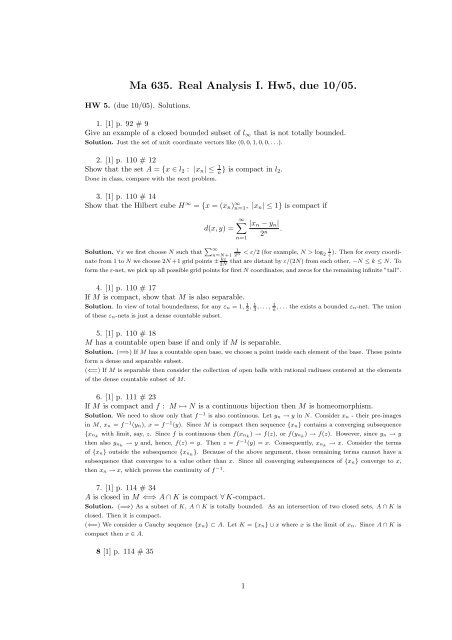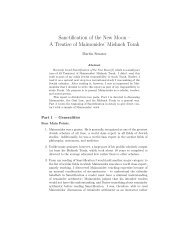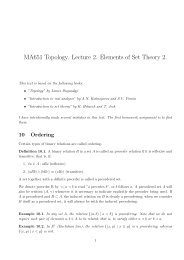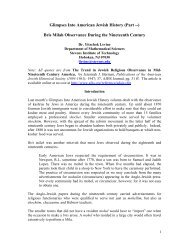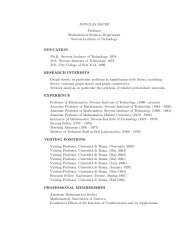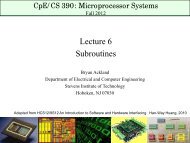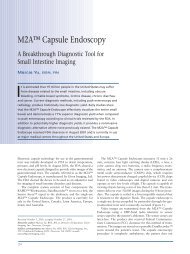Ma 635. Real Analysis I. Hw5, due 10/05.
Ma 635. Real Analysis I. Hw5, due 10/05.
Ma 635. Real Analysis I. Hw5, due 10/05.
You also want an ePaper? Increase the reach of your titles
YUMPU automatically turns print PDFs into web optimized ePapers that Google loves.
<strong>Ma</strong> <strong>635.</strong> <strong>Real</strong> <strong>Analysis</strong> I. <strong>Hw5</strong>, <strong>due</strong> <strong>10</strong>/<strong>05.</strong><br />
HW 5. (<strong>due</strong> <strong>10</strong>/05). Solutions.<br />
1. [1] p. 92 # 9<br />
Give an example of a closed bounded subset of l∞ that is not totally bounded.<br />
Solution. Just the set of unit coordinate vectors like (0, 0, 1, 0, 0, . . .).<br />
2. [1] p. 1<strong>10</strong> # 12<br />
Show that the set A = {x ∈ l2 : |xn| ≤ 1<br />
n } is compact in l2.<br />
Done in class, compare with the next problem.<br />
3. [1] p. 1<strong>10</strong> # 14<br />
Show that the Hilbert cube H ∞ = {x = (xn) ∞ n=1, |xn| ≤ 1} is compact if<br />
d(x, y) =<br />
∞<br />
n=1<br />
|xn − yn|<br />
2n .<br />
Solution. ∀ ε we first choose N such that ∞ 1<br />
n=N+1 2n 1<br />
< ε/2 (for example, N > log2 ). Then for every coordi-<br />
ε<br />
nate from 1 to N we choose 2N +1 grid points ± kε<br />
that are distant by ε/(2N) from each other, −N ≤ k ≤ N. To<br />
2N<br />
form the ε-net, we pick up all possible grid points for first N coordinates, and zeros for the remaining infinite ”tail”.<br />
4. [1] p. 1<strong>10</strong> # 17<br />
If M is compact, show that M is also separable.<br />
Solution. In view of total boundedness, for any εn = 1, 1 1 1<br />
, , . . . , 2 3 n , . . . the exists a bounded εn-net. The union<br />
of these εn-nets is just a dense countable subset.<br />
5. [1] p. 1<strong>10</strong> # 18<br />
M has a countable open base if and only if M is separable.<br />
Solution. (=⇒) If M has a countable open base, we choose a point inside each element of the base. These points<br />
form a dense and separable subset.<br />
(⇐=) If M is separable then consider the collection of open balls with rational radiuses centered at the elements<br />
of the dense countable subset of M.<br />
6. [1] p. 111 # 23<br />
If M is compact and f : M ↦→ N is a continuous bijection then M is homeomorphism.<br />
Solution. We need to show only that f −1 is also continuous. Let yn → y in N. Consider xn - their pre-images<br />
in M, xn = f −1 (yn), x = f −1 (y). Since M is compact then sequence {xn} contains a converging subsequence<br />
{xn k with limit, say, z. Since f is continuous then f(xn k ) → f(z), or f(yn k ) → f(z). However, since yn → y<br />
then also yn k → y and, hence, f(z) = y. Then z = f −1 (y) = x. Consequently, xn k → x. Consider the terms<br />
of {xn} outside the subsequence {xn k }. Because of the above argument, those remaining terms cannot have a<br />
subsequence that converges to a value other than x. Since all converging subsequences of {xn} converge to x,<br />
then xn → x, which proves the continuity of f −1 .<br />
7. [1] p. 114 # 34<br />
A is closed in M ⇐⇒ A ∩ K is compact ∀ K-compact.<br />
Solution. (=⇒) As a subset of K, A ∩ K is totally bounded. As an intersection of two closed sets, A ∩ K is<br />
closed. Then it is compact.<br />
(⇐=) We consider a Cauchy sequence {xn} ⊂ A. Let K = {xn} ∪ x where x is the limit of xn. Since A ∩ K is<br />
compact then x ∈ A.<br />
8 [1] p. 114 # 35<br />
1
Every open cover G of compactum M has a Lebesgue number L(G) > 0. By definition,<br />
L(G) = inf<br />
ε>0 {∀Bε ⊂ M ∃G ∈ G : Bε ⊆ G}.<br />
Solution. If a cover G has no positive Lebesgue number, then it is equal to zero. Then ∀ {εn} ∞ n=1 , εn → 0,<br />
∃Bεn ⊂ M such that ∀G ∈ G, Bεn ⊂ G. Let {Gn} N n=1 be a finite open subcover of G that covers M. We<br />
consider the open subsets Dn = Bεn \ Gn. They are non-empty (otherwise Bεn ⊂ Gn). Their intersection is also<br />
non-empty (why?). Then N n=1 Dn ⊂ M, which contradicts the inclusion Dn ⊆ M for all n.<br />
9 [1] p. 114 # 36<br />
<strong>10</strong> [2], p. 81, # 4.<br />
Show that E = {1/n : n a positive integer } is not compact in R but E ∪ {0} is compact.<br />
11 [2], p. 81, # 7.<br />
Prove that every finite subset of a metric space is compact.<br />
Solution. Any sequence from a finite subset contains a stationary subsequence, which is convergent.<br />
12 [2], p. 81, # 6.<br />
Show that a discrete metric space M is not compact unless X is finite.<br />
Solution. Let xn be a countable infinite sequence in M. Since the distance between any two points is equal to<br />
1, this sequence has no converging subsequence and, thus, is not compact.<br />
13 [2], p. 81, # 9<br />
If X is compact prove that C(X, R) is a complete metric space.<br />
Slightly modify the theorem from Advanced Calculus that states that the uniform convergence of continuous<br />
functions yield a continuous function as the pointwise limit.<br />
14 [2], p. 81, # <strong>10</strong><br />
Is C[0, 1] compact?<br />
No, xn(t) = t n is a not relatively compact subset, its pointwise limit is a discontinuous function.<br />
15. [2], p. 84, # 4 Prove that any compact metric space has a dense countable subset.<br />
See # 4.<br />
16. [3], p. 115, # 5<br />
Let X be a metric compactum and A : X ↦→ X such that d(Ax, Ay) < d(x, y) if x = y. Prove<br />
that A has a unique fixed point.<br />
Solution. Consider arbitrary x0 and let xn = Ax0. Let d1 = d(x0, x1), d2 = d(x1, x2), . . .. As we know,<br />
d1 > d2 > d3 > · · ·. Since X is compact, we pick up xn k - a converging subsequence of {xn}, xn k → z0 as<br />
k → ∞. That implies d(xn k , xnm ) → 0 as k, m → ∞. We consider the sequence Axn k = xn k+1. From the<br />
problem statement, d(Axn k , Axnm) < d(xn k , xnm ) → 0. Hence, the sequence Axn k+1 is also a Cauchy sequence,<br />
let its limit be z1. Similarly, we obtain ∃ lim xn k+2 = z2, ∃ lim xn k+3 = z3, and so on. The number of limit<br />
points z0, z1, z2, . . . cannot exceed nk+1 − nk since the sequence xn k+1 is just xn k and, hence, xn k+1 → z0. So,<br />
we have limit points z0, z1, . . . , zp. The condition d(Ax, Ay) < d(x, y) implies that A is a continuous mapping.<br />
Since xn k → z0 then Axn k → Az0. Consequently, z1 = Az0. Similarly, z2 = Az1, z3 = Az2, z0 = Azp. However,<br />
the condition d(Ax, Ay) < d(x, y) implies that there may not be a periodic orbit. <strong>Real</strong>ly,<br />
d(z1, z0) = d(Az0, Azp) < d(z0, zp) = d(Azp, Azp−1) < · · · < d(z2, z1) = d(Az1, Az0) < d(z1, z0).<br />
The contradiction d(z1, z0) < d(z1, z0) proves the absence of any periodic orbit. So, z0 = z1 = . . . = zp is the<br />
only fixed point: z0 = Az0.<br />
17. Prove that a uniformly bounded set of functions in C[a, b], which satisfy the Lipshitz<br />
condition with the same common constant, is compact in C[a, b].<br />
x(t) satisfies the Lipshitz condition with constant L if ∀t, s : |x(t) − x(s)| ≤ C|t − s|.<br />
2
18. Determine whether the following sets in C[0, 1] are relatively compact (pre-compact):<br />
(a) xn(t) = sin(nt)<br />
Not relatively compact: [sin(nt)] ′ = n cos(nt) = n → ∞ at t = 0.<br />
(b) xn(t) = sin(t + n)<br />
This set is pre-compact: |x ′ n(t)| = | cos(t + n)| ≤ 1. Uniform boundedness of slopes implies equicontinuity.<br />
(c) xα(t) = arctan(αt), α ∈ R<br />
Not pre-compact. Do like in (a)<br />
(d) xα(t) = e t−α , α ∈ R, α ≥ 0.<br />
Pre-compact. |x ′ α(t)| = e t−α ≤ e since 0 ≤ t ≤ 1.<br />
Bonus 2: Prove that the condition d(f(x), f(y)) < d(x, y), x = y, is insufficient for the existence<br />
of a fixed point of function f.<br />
Solution. Consider in usual metric f : [0, ∞) ↦→ [0, ∞), f(x) = x+ 1<br />
. The graph y = f(x) is above the bisector<br />
x+1<br />
y = x and approaches it as x → ∞. Its slope is positive but less than 1 at all points. Hence, d(f(x), f(y)) < d(x, y).<br />
Bonus 3; [1] p. 111 # 24.<br />
References<br />
[1] Carothers N.L., <strong>Real</strong> <strong>Analysis</strong>. Cambridge University Press, 2000.<br />
ISBN 0521497493 or ISBN 0521497566.<br />
[2] Kolmogorov, A.N., and Fomin, S.V., Introductory <strong>Real</strong> <strong>Analysis</strong>. Dover, 1970.<br />
ISBN 0486612260.<br />
[3] Haaser, N.B., and Sullivan, J.A., <strong>Real</strong> <strong>Analysis</strong>. Dover, 1991.<br />
ISBN 0486665097.<br />
[4] Rudin, W., <strong>Real</strong> and Complex <strong>Analysis</strong>, 3d ed. McGraw-Hills, 1987.<br />
[5] Folland, G.B., <strong>Real</strong> <strong>Analysis</strong>. Wiley, 1984.<br />
[6] Reed, M. and Simon, B., Methods of Modern <strong>Ma</strong>thematical Physics. 1. Functional <strong>Analysis</strong>. Academic Press<br />
1972.<br />
[7] Oxtoby, J.C., Measure and Category. A survey of the Analogies between Topological and Measure Spaces.<br />
Springer-Verlag, 1971.<br />
3


